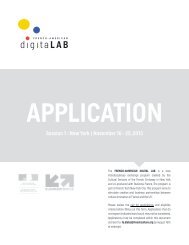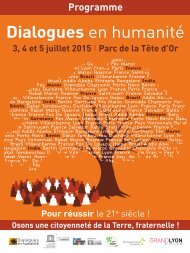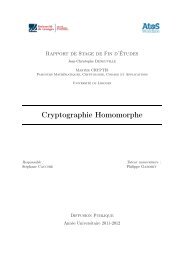REX
BD16_REX
BD16_REX
You also want an ePaper? Increase the reach of your titles
YUMPU automatically turns print PDFs into web optimized ePapers that Google loves.
Retours d’expériences Big Data en entreprise<br />
CRAY - INSTITUTE FOR SYSTEMS BIOLOGY<br />
CRAY SOLUTION BRIEF | CANCER RESEARCH USING<br />
A BIG DATA APPROACH<br />
THE CHALLENGE<br />
Cancer researchers have a wealth of data available to them regarding the molecular and clinical characteristics of<br />
the many forms of cancers and the use of therapeutic drugs to treat disease. This data includes both proprietary<br />
research from their own labs as well as publicly available data such as The Cancer Genome Atlas and other collaborative<br />
scientific and public sources.<br />
The hypothesis is that big data could be used to identify potential new drug treatments from data already available<br />
through analysis of gene-drug relationships without performing “wet” lab work first.<br />
However, traditional analytics tools and techniques to test these hypotheses often take several weeks to months<br />
to execute. They are time consuming because data scientists must assemble all of the necessary data into a new<br />
data model to determine whether the researcher’s hypothesis is accurate. Because of the extensive amount of time<br />
between question and answer, the results of the experiment may be irrelevant by the time they are finally delivered.<br />
The researchers at the Institute for Systems Biology (ISB) wanted to determine whether they could significantly<br />
compress this wait time. They wanted a way to get to “yes” or “no” quickly in order to prioritize drug repurposing<br />
opportunities; this would then accelerate the discovery of new cancer treatments that could be moved through the<br />
drug development and approval process quickly, thus making a major difference to cancer patients.<br />
THE URIKA-GD PLATFORM ADVANTAGE:<br />
To rapidly validate scientific hypotheses in real time and discover new connections within their<br />
existing data, the ISB team needed a powerful solution that enabled data discovery at scale.<br />
THE SOLUTION<br />
The ISB team worked with Cray to develop an innovative, real-time approach to cancer research discovery using<br />
the Urika-GD graph analytics appliance. Using the Urika-GD system, the team was able to assemble all of its<br />
data into a single graph in the appliance’s vast shared memory — eliminating the need to partition the data or create<br />
time-consuming and complex data models prior to posing a hypothesis. This solution is scalable, which allows<br />
the data set to expand over time without losing performance or data integrity.<br />
The ISB team identified new cancer therapy candidates by exploring correlations between frequently mutated<br />
genes from tumor samples to identify existing gene-drug associations that could be possible drug candidates. In<br />
addition to discovering promising new therapies, they also sought to rapidly eliminate from consideration those<br />
drugs that would not deliver the desired result..<br />
To deliver results quickly, the researchers needed a way to discover unknown relationships within the data that the<br />
current data management strategy couldn’t deliver. The Urika-GD system enabled ISB’s researchers to look at the<br />
data in a different way than what they’d be limited to with query-based relational database systems, where the data<br />
determines what questions can be asked. This resulted in a clear visualization of the connections and associations<br />
within the data to help identify promising candidates for new therapies.<br />
The graph analytics approach enabled the research team to identify thousands of drug repurposing opportunities<br />
that warranted further investigation. For example, this methodology revealed that nelfinavir, which is used to treat<br />
HIV, showed selectivity in a separate research study for HER2-breast cancer. The ISB team came to the same<br />
conclusion about nelfinavir in a fraction of the time, with no need for hands-on “wet lab” work to test the hypothesis<br />
- validating the accuracy and efficacy of the big data approach for identifying drug treatment solutions.<br />
THE URIKA-GD PLATFORM ADVANTAGE<br />
The Urika-GD system, with its large global shared memory, RDF/SPARQL interface and proprietary Threadstorm<br />
multithreaded graph processors, allowed the team to rapidly integrate ISB’s proprietary data with publicly available<br />
data, enabling the researchers to identify new relationships in the data without any upfront modeling. No advance<br />
knowledge of the relationships within the data is required to identify non-obvious patterns, facilitating true data<br />
discovery.<br />
Using the Urika-GD platform instead of traditional database strategies and investigative laboratory experiments,<br />
the ISB researchers significantly reduced the time to discovery, saving months or years of research with a higher<br />
probability of success.<br />
Document réalisé par la Société Corp Events - Janvier 2015<br />
20







